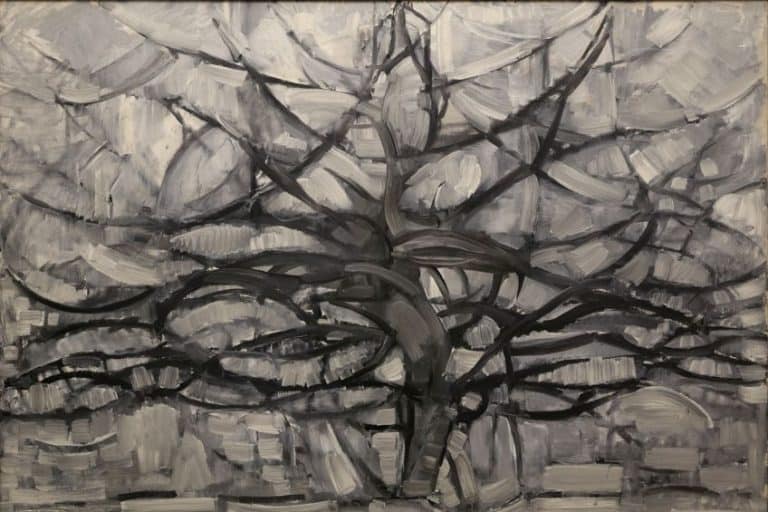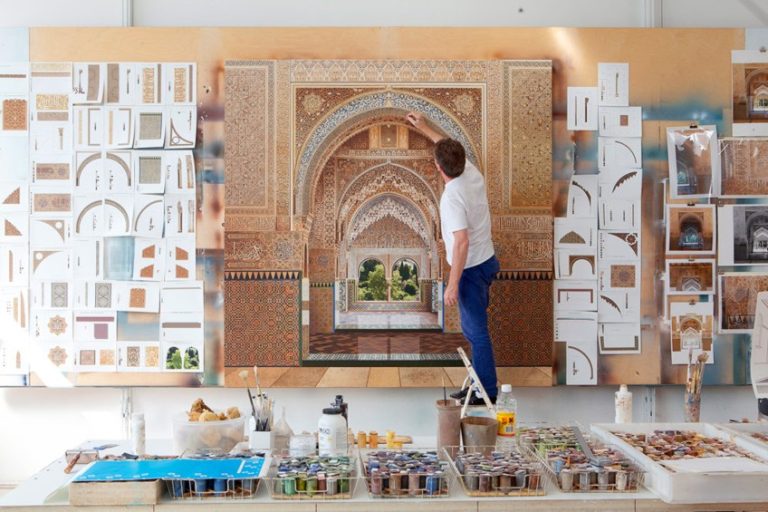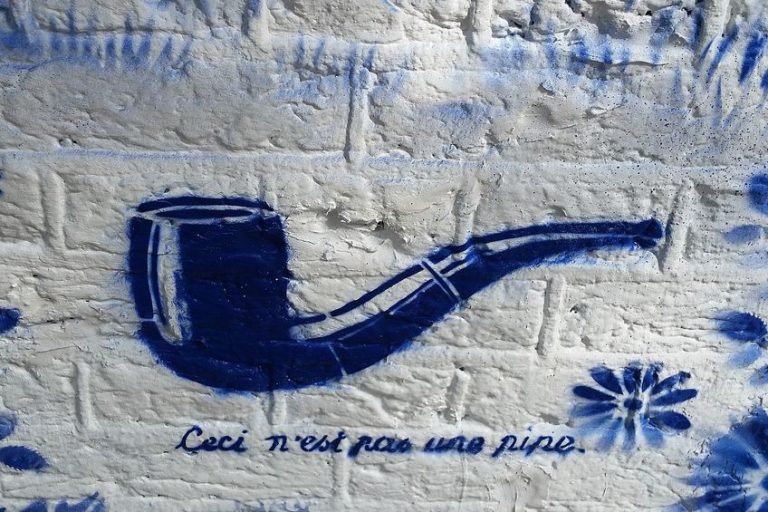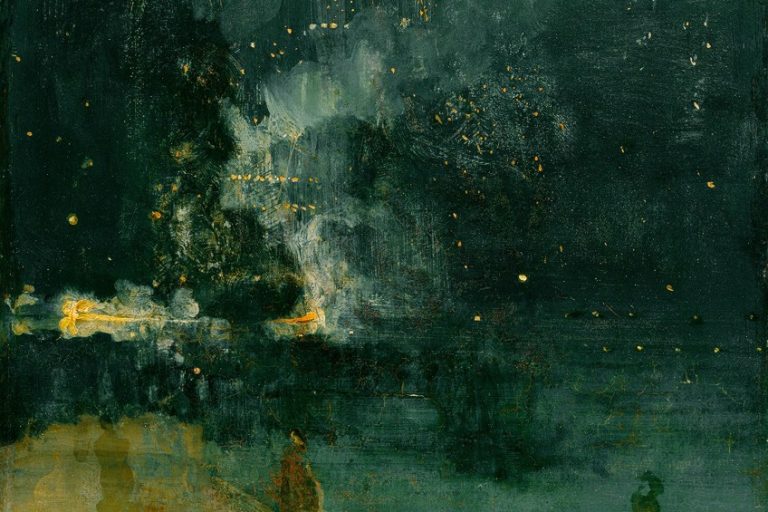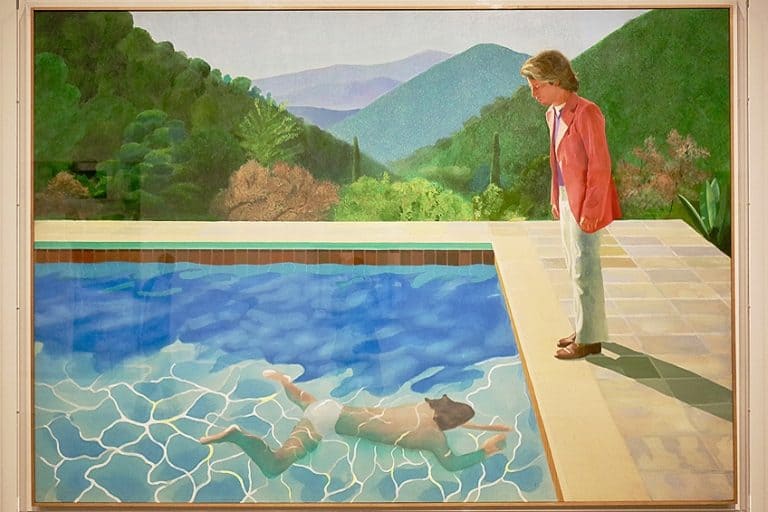“The Last Judgement” Michelangelo – The Sistine Chapel Masterpiece
The familiar Biblical prophecy about the Last Judgment, also known as Christ’s Second Coming, has been the subject matter for numerous religious paintings throughout the western art world. This article will explore one such painting that has become one of the most famous and beautiful renderings of a somewhat serious subject, The Last Judgment fresco by Michelangelo.
Artist Abstract: Who Was Michelangelo?
Michelangelo di Lodovico Buonarroti Simoni, or simply known as Michelangelo, was active during the High Renaissance and Mannerist art periods as a sculptor, architect, and painter. He was considered as one of the best artists among the greats like Leonardo da Vinci. He was born in the Caprese village in Tuscany, Italy during the 1400s.
From a young age, Michelangelo loved art and would copy paintings in churches. He studied at the Platonic Academy in Florence and apprenticed with Lorenzo de’ Medici. He sculpted primarily in marble and is famous for his sculptures David (1501 to 1504) and the Pietà (1498 to1499), among others.

The Last Judgment by Michelangelo in Context
The Last Judgement by Michelangelo spans across the whole altar wall of the Sistine Chapel in Italy. It is certainly not a passive piece of art and is made to elicit awe and fear, depicting over 300 (mostly nude) figures surrounding the central figure of Christ, all dynamically engaged. It was completed over 20 years after Michelangelo painted the Biblical narratives from the Book of Genesis on the Sistine Chapel’s ceiling, which includes the famous fresco called The Creation of Adam (c. 1508 to 1512).
| Artist | Michelangelo di Lodovico Buonarroti Simoni |
| Date Painted | 1536 to 1541 |
| Medium | Fresco Painting |
| Genre | Religious History Painting |
| Period | High Renaissance / Early Mannerist |
| Dimensions | 13.7 x 12 meters |
| Series / Versions | Part of the Sistine Chapel frescoes |
| Where is it housed? | Sistine Chapel, Vatican City, Rome, Italy (Vatican Museums) |
| What It Is Worth | Estimated worth is $540 million |
Below we discuss The Last Judgment painting in more detail, first exploring its historical context, why it was painted, and who the leading figures were that made it possible. We will also discuss why it was painted on the altar wall. Second, we will look at some of the formal elements involved in this fresco’s creation, for example, the subject matter, themes, and painting techniques.
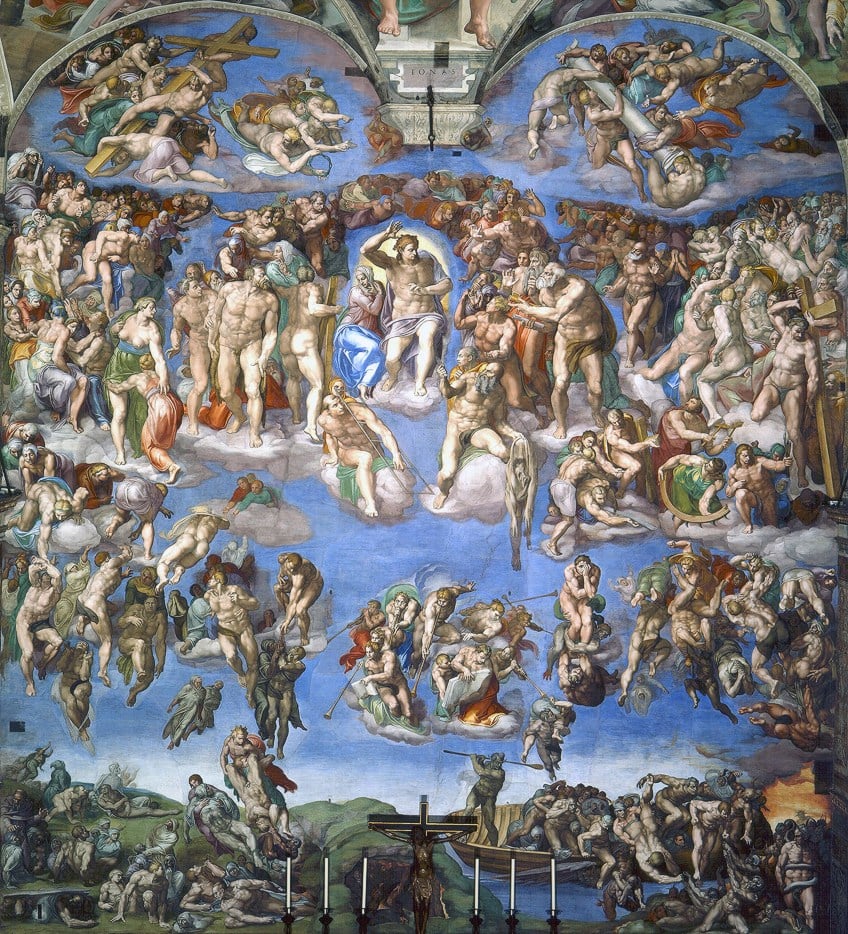
Contextual Analysis: A Brief Socio-Historical Overview
The Sistine Chapel is part of the Apostolic Palace in the Vatican City in Rome, Italy. It is one of the most famous buildings in the world, not only because the Apostolic Palace is the home of the Pope and the Papal Conclave where the new Pope is elected, but the Sistine Chapel is home to some of the greatest selections of artwork ever created in Western art history.
Knowing a little bit more about the Sistine Chapel will give us a better understanding of its vastness. The Sistine Chapel was initially built on the site of the older chapel called Cappella Maggiore. In 1473 Pope Sixtus IV commissioned its complete renewal. It was also renamed after him. Although there is scholarly speculation, it is believed the architect Giovannino de Dolci was involved in the Chapel’s reconstruction along with the designer Baccio Pontelli.
In 1508 Pope Julius II commissioned Michelangelo to paint the Sistine Chapel’s ceiling; this was done between 1508 and 1512.
Why Paint the Sistine Chapel’s Altar Wall?
Paintings like The Last Judgment were usually painted on the west end of churches, near the back doors. This served the purpose for when people left the church, they would be met with one final message to take with them, and what other than the Last Judgment? However, Michelangelo painted The Last Judgment on the east end, which is the altar wall.
Pope Clement VII (1523 to 1534) commissioned The Last Judgment painting; however, after his death, it was taken over by Pope Paul III (1534 to 1549). Some sources indicate that each Pope had different views of what they wanted for the altar wall painting, but the subject matter was indicated as the Resurrection by Pope Clement VII.
The subject of the Resurrection may have been misunderstood by some as being the Resurrection of Christ, but in fact, it was the Resurrection of the dead on Judgment Day.
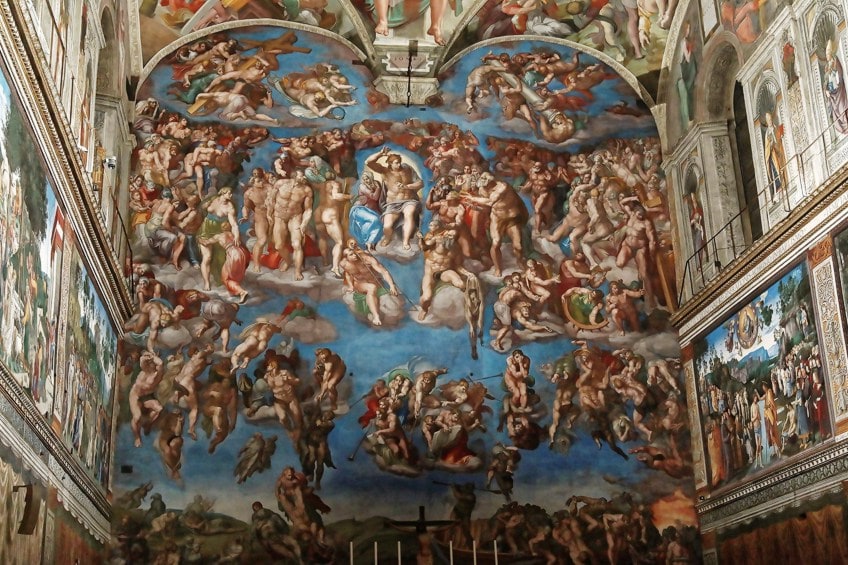
Not too long before the altar was painted the Sack of Rome in 1527 wreaked havoc in Italy, especially destabilizing the foundations of the Papacy, but also leaving the city of Rome bankrupt and pillaged. The Sack was also believed to have ended the Renaissance period.
The army under the rule of the Holy Roman Emperor, Charles V, infiltrated Rome for food and money during the War of the League of Cognac. However, the attacks were also against the Catholic Church and the Papacy. This was also a time when Martin Luther, a German theologian, initiated the Protestant Reformation.
The Protestant Reformation was believed to have started during 1517 when Martin Luther published his Ninety-Five Theses, which addressed – or “protested” – the selling of indulgences by the Papacy. The Catholic Church’s reaction ushered in the Counter-Reformation.
So, in a nutshell, the brief overview of the above-mentioned events, which would need an entirely separate article to unpack, outlines the catalysts for why the Sistine Chapel’s altar wall was painted to depict the Last Judgment.
The Pope, undoubtedly, sought to restrengthen the Papacy’s reputation and the Catholic Church’s doctrines after the Protestant Reformation.
Additionally, through the powerful means of art, the Catholic Church and Rome needed to rebuild themselves after the devastation from the Sack. The message the Pope conveyed through The Last Judgment painting was almost like taking a stand for all the events against the Papacy.

Anyone visiting the chapel would come face-to-face with the painting, unable to avoid the prophetic narrative of Christ’s Second Coming and the idea of Hell and torture seen in the hundreds of human bodies depicted on the wall. It was almost like a reminder about justice against perpetrators, in this case, the troops who sacked the city of Rome and held it hostage. This was an understandable agenda on the Pope’s part and using the vehicle of painting was the best way to teach and communicate to people, especially those who acted violently against the Church.
Of course, the other reason for the Last Judgment painting was because of Michelangelo’s highly prestigious skills in painting the human figure and because he painted the Sistine Chapel’s ceiling.
Formal Analysis: A Brief Compositional Overview
It is clear from the title of the painting and the sheer scale of visuals that fill up the entire wall that the primary theme is that of justice, judgment, and really the power of Heaven over Hell, the power of good over evil.
It is a visual reminder for all who visited the Chapel of their fate and standing in the Catholic religion.
Even in the present day, with hundreds of tourists visiting the Chapel, it continues to be a stark reminder of the Christian religion and the age-old Biblical narrative of the Last Judgment. Below we take a closer look at the subject matter and how this monumental painting was created.
Subject Matter – The Last Judgment Embodied
As we look at the famous Sistine fresco, we are met with a whole wall space occupied by figures in dynamic poses and expressions. The composition as a whole is also divided into respective groups and quadrants. There is a successive flow for the progression of the resurrected, starting from the bottom left corner, the resurrected move upwards from their graves towards heaven.
Some are assisted by angels, notably the couple being pulled up by rosary beads, and others rise without any assistance. We will also notice one of the figures caught between the grips of an angel and a demon, the latter trying to pull the body down towards Hell.
To the right of the composition, we notice the figures who are on their way to Hell and angels vigorously warding those away from the reaches of Heaven. The bottom right corner is filled with tormented souls who embody various sins. For example, the figure with the golden money bag and set of keys hanging from his neck represents avarice, the sin of greed. Another figure is pulled by his scrotum, representing the sin of lust; another figure is fighting the process, he represents pride.
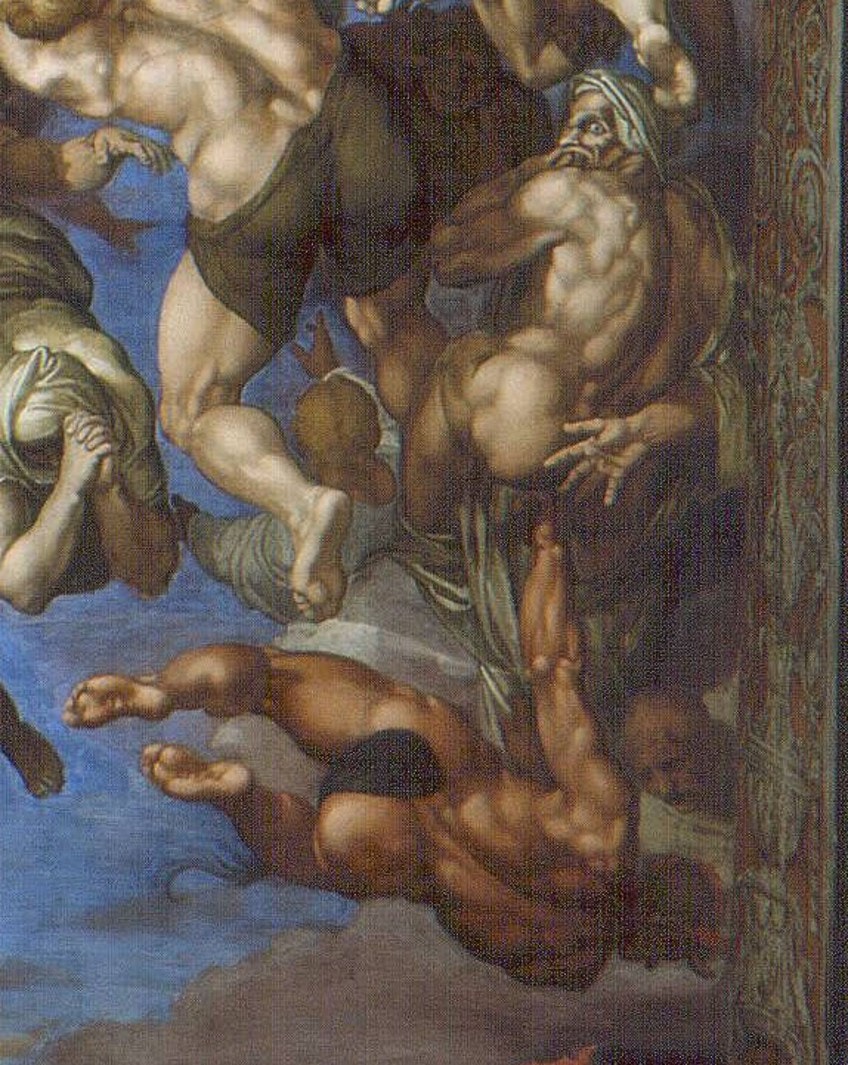
There are notable figures on the bottom right, for example, Charon, from Greek mythology he is known as the ferryman who transports souls to the underworld, stands in his small boat, holding his oar up ready to swing it at the souls in front of him, ushering them onto the hellish shores that are to be their fate. The figures are met by Minos, one of the judges for those entering Hell. He has donkey ears and a serpent wrapped around his body and biting his genitals.
Christ is at the center of the composition, with Mother Mary to his right (our left), her head is meekly turned to the side.
From original preparatory sketches, Mary was in a pleading stance with open arms, however, with the events taking place in this painting, the final judgment of Christ is already taking place and there is no more time for Mary to plead with him. The figure of Mary pleading is commonly depicted in Last Judgment paintings.
Christ’s figure is surrounded by various saints, martyrs, and angels, who are referred to as the elect. To His left (our right) are prominent Apostles like Saint Peter, who holds the keys to heaven in his hands. It also appears as if he is giving these back to Christ, which indicates that his role as the keeper of these keys is finished. To Christ’s right (our left) is St. John the Baptist; he is recognizable due to the camel pelt covering his groin and hanging behind him.
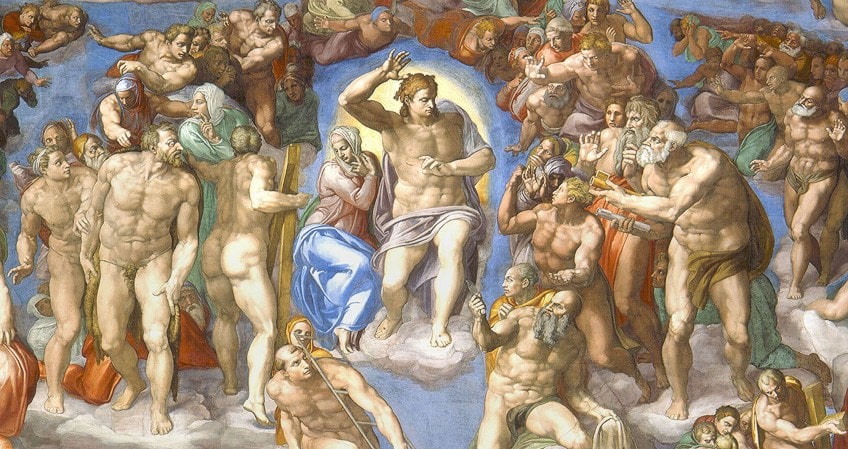
Other notable figures surrounding Christ are, namely, St. Andrew, holding the cross next to Christ, St. Lawrence holding the grate, the figure with the knife and flayed skin is St. Bartholomew – a fun fact about the flayed skin is that Michelangelo painted his face or self-portrait on it, which appears difficult to see due to the sagging skin – the figure holding the wool combs is St. Blaise, St. Catherine holds a wheel, and the figure holding the arrows is St. Sebastian.
There is another group of angels holding trumpets below the group of Christ, which is a reference to the trumpet call as explained in the Bible in the Book of Matthew (24: 30 to 31):
“Then will appear the sign of the Son of Man in heaven. And then all the peoples of the earth will mourn when they see the Son of Man coming on the clouds of heaven, with power and great glory. And he will send his angels with a loud trumpet call, and they will gather his elect from the four winds, from one end of the heavens to the other”.

The upper part of the composition features two lunettes and depicted in these are the symbols from Christ’s Passion, namely, the Cross, Christ’s Crown of Thorns, and the Pillar he stood against when he was flagellated, otherwise referred to as scourging, and others like the Ladder. The angels are wingless and could be representing the idea of Christ’s sacrifice and resurrection, which were the catalysts of Christ’s Second Coming.
Throughout the entire composition we notice hundreds of figures, each figure appears to be in a heightened emotional state. There is an overall compositional commotion with many in the throes of anguish and anticipation, from bottom to top, left to right.
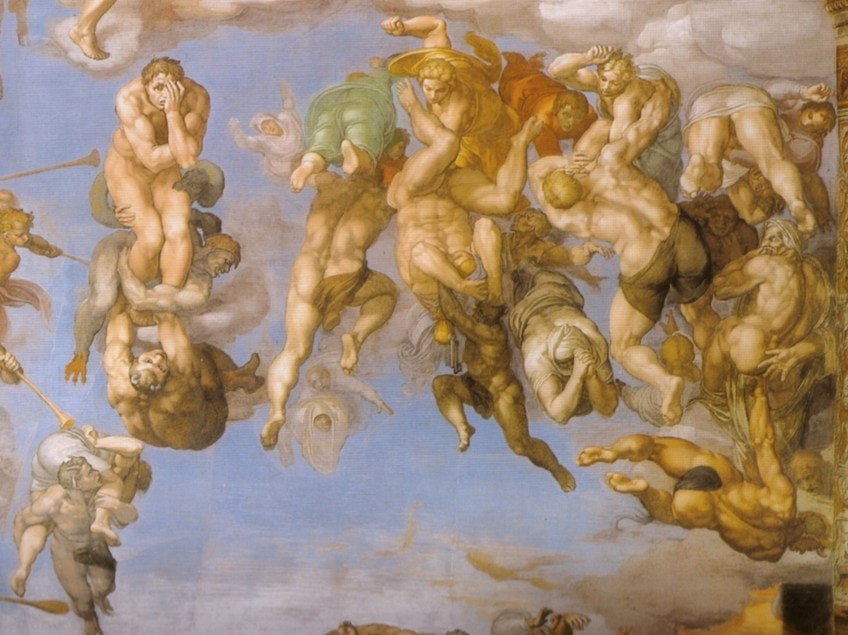
A noticeable figure emanating the sheer disbelief of what is happening to him is depicted to the left of the group of trumpeting angels (our right), but we will notice this anguish in many figures floating around in the background, almost like scepters of their former human selves. In the group of figures at the top right are three sets of male couples kissing and holding one another.
This entire event is set behind a landscape of blue skies, which takes up most of the composition. The bottom third of the landscape depicts a green mountainous region with a river winding between it in the middle, which flows towards the right-hand side where we notice the fiery opening of Hell.
Behind the figure of Christ is a golden yellow light, suggestive of the Sun, emphasizing his prominence and power. Some sources suggest that it is reminiscent of the Greek mythological god Apollo who was the god of the Sun.
Michelangelo’s Metaphors
Michelangelo incorporated many symbolic references and metaphors in The Last Judgment painting, some mentioned above. However, he also made strong references to the writings of the Italian poet Dante Alighieri. Here he included several references from the first part, Inferno, of Dante’s poem titled The Divine Comedy (c. 1308 to 1320).
The poem is divided into three parts, starting with the Inferno (“Hell”), the Purgatorio (“Purgatory”), and lastly, Paradiso (“Paradise”).
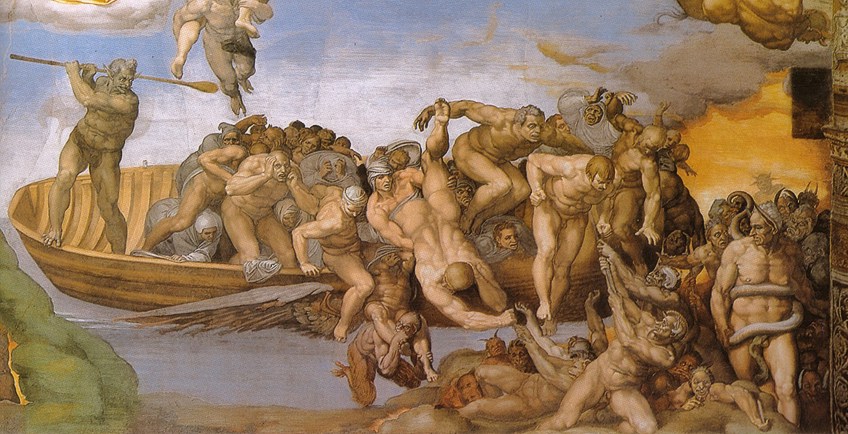
We see these references in the lower right corner with the characters of Charon and Minos, who in the Divine Comedy, served the same role as in the painting. Charon was the ferryman who took Dante across the river Acheron in the poem. Minos was the demon who judged the souls entering Hell.
In Dante’s poem, there were nine circles comprising Hell and Minos would wrap his tail, which looked like a serpent’s tail, around his body in the number that would correspond with the circle of Hell. Michelangelo made these references fit for educated audiences who would pick up on all the visual cues and metaphors.
Painting Technique: Color, Light, and Texture
The color and lighting of The Last Judgment painting is a light hue, we see this in the blue sky making up most of the composition and the light skin tones of the figures. Furthermore, we see the color tones contrast near the bottom of the painting where the figures appear grayer.
There seems to be a light source illuminating the top two-thirds of the painting and as it moves downwards there is more shadow, which is fitting for the subject matter of the painting.
Just like the Sistine Chapel’s ceiling, The Last Judgment painting was done as a fresco, and knowing it was a Renaissance painting will indicate how artists during this time painted. The fresco technique was commonly used among artists, especially for large surface areas like the wall of a church for example.

Perspective and Scale
As we already know, The Last Judgment painting is located on the whole wall behind the Sistine Chapel’s altar and it took some sacrifice to accomplish this enormous (literally and figuratively) undertaking. Previous existing frescoes by the artist Pietro Perugino were destroyed as the wall was prepared and plastered for this painting; additionally, two lunettes were also destroyed.
Two clerestory windows also had to be bricked up to create more surface area for the painting, along with three cornices, and the wall was built up near the top, giving it a forward-leaning effect – this was also done to prevent dust from falling onto the painting and to improve the perspective.
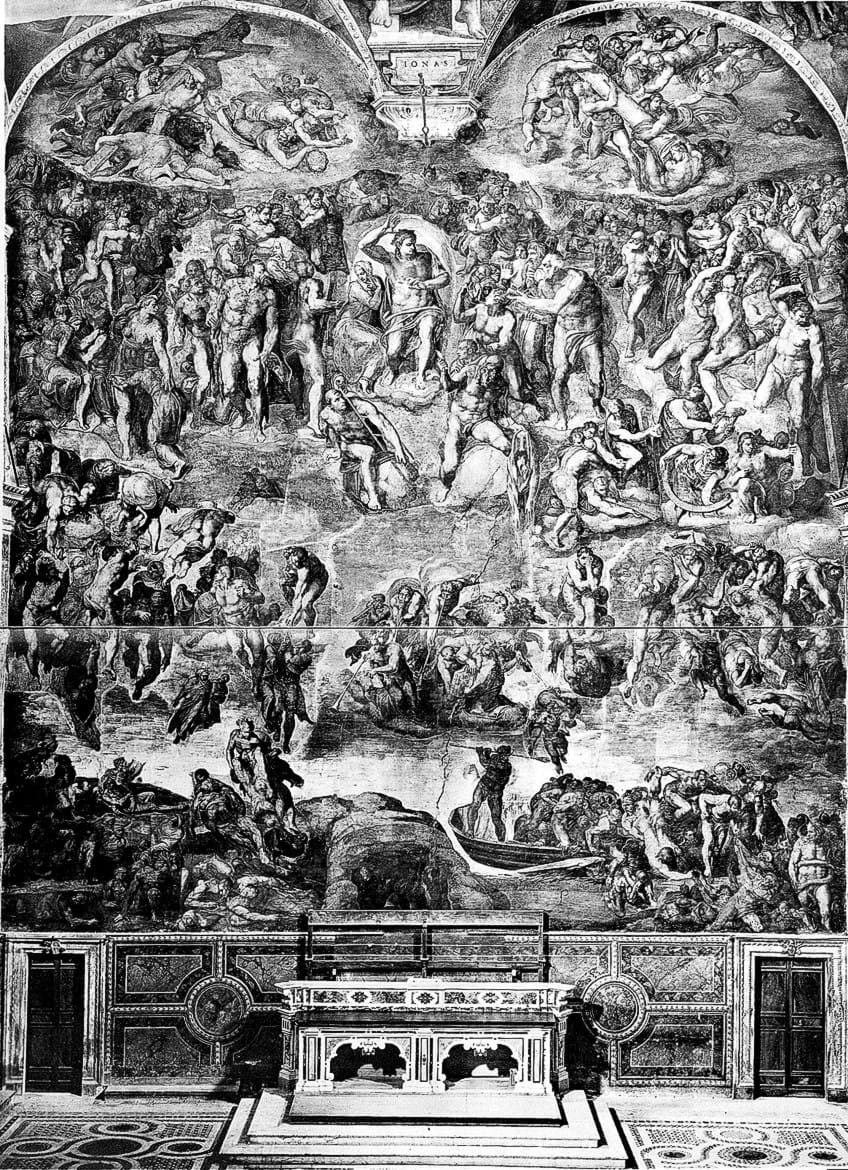
The perspective in The Last Judgment is different from other paintings where figures receded in space with the use of the linear perspective technique, this technique was utilized to create depth. Michelangelo created a sense of depth in another manner, this was by overlapping his figures and the figures further back were painted “thinly” and in lighter tones to suggest spatial awareness.
Michelangelo also did not paint with a frame, which gave the painting a sense of continuity. We will notice some figures around the edges are cut off, this is evident around all the edges of the painting, top to bottom left to right. This effect gives the composition an eternal sense of movement and action.
Reception of The Last Judgment: Mixed Feelings
The Last Judgment painting is a quite controversial version of the Last Judgment prophecy compared to other versions like those of Gothic and Proto-Renaissance painter Giotto di Bondone. It sparked a lot of critique and praise when it was unveiled in 1541. It was caught between those in the Catholic Church who were still feeling the effects of the Protestant Reformation and those who appreciated Michelangelo’s mastery and skill.
Most of the criticism was around the explicit nudity of the figures and how Michelangelo combined mythology with religious subjects.
There is also an interesting tale about this painting and the character of Minos, standing near the opening of Hell, in the bottom right corner. The painting received significant criticism from Biagio da Cesena, the Papal Master of Ceremonies to Pope Paul III.

The Italian writer and historian, Giorgio Vasari, accounts from his publication, Lives of the Artists (1550), that da Cesena vehemently gave his opinion about the painting while visiting the Chapel with the Pope, which was shortly before the painting was completed. Da Cesena said, “that it was a very disgraceful thing to have made in so honorable a place all those nude figures showing their nakedness so shamelessly, and that it was a work not for the chapel of a Pope”. He further stated that it belongs in a place like a “brothel”.
Michelangelo was not pleased about this criticism, and he painted da Cesena’s portrait as that of Minos’s character in the painting, with a snake coiling itself around his body and biting his genitalia. De Cesena complained about this to the Pope, but the Pope supposedly said that his “authority does not extend into Hell”.
Other criticisms came from the correctness of rendering religious figures, for example, the “classicized” figure of Christ who appeared Apollonian and beardless, although the beardless Christ has been depicted before. Furthermore, Christ was not seated on a throne as was standard from the Biblical scriptures but standing. Some of the angels were wingless and had a sense of weather as indicated by the wind blowing the garments, however, as the scriptures state, the weather would stop on Judgment Day.

In 1563, the Council of Trent introduced new rules aligned with the Counter-Reformation’s stance on how art should be depicted. Among these stipulations was the case for depicting nudity. The Council decreed that all superstitious and lascivious images need to be avoided. Additionally, there was a specific decree that stated that all images in the Apostolic Chapel needed to be covered.
After these events took place, it was ordered that all genitalia be covered over, which was done by the Mannerist artist Daniele da Volterra. He received the nickname Il Braghettone, which means “the breeches-maker”.
Some of the positive praises were from one of the agents of Cardinal Gonzaga of Mantua, who stated, “The work is of such beauty that your excellency can imagine that there is no lack of those who condemn it…[T]o my mind it is a work unlike any other to be seen anywhere”.
The Last Judgment painting has indeed been the subject of numerous criticisms and praises. There have also been modern critiques, for example, from the British art historian Anthony Blunt. He is quoted as having stated, “This fresco is the work of a man shaken out of his secure position, no longer at ease with the world, and unable to face it directly. Michelangelo does not now deal directly with the visible beauty of the physical world”. Michelangelo was believed to have focused on the spiritual in life and not so much on the material world.

Other art critics of the Renaissance like Sydney Joseph Freedberg, explains more about the way Michelangelo chose to depict his nude figures, stating, “The vast repertory of anatomies that Michelangelo conceived for the Last Judgment seems often to have been determined more by the requirements of art than by compelling needs of meaning, … meant not just to entertain but to overpower us with their effects”.
If we look at Michelangelo’s nude figures, they are in a way, overpowering. We even notice the musculature of the females in the painting. All the figures share this similar muscularity, which was characteristic of Michelangelo’s style of the time. He was known for rendering his subjects with astute anatomical correctness.
However, we could argue that his figures veer on the border of exaggeration.
It is also reported that the Italian painter, Annibale Carracci, compared the figures in The Last Judgment painting to the figures on the Sistine Chapel’s ceiling as “too anatomical”. This painting went on to become a model for students to practice their artistic skills and study the nude figure, but this was also cautioned against by other artists and critics who advised people to be aware of not depicting the female figure like that of the male figure.
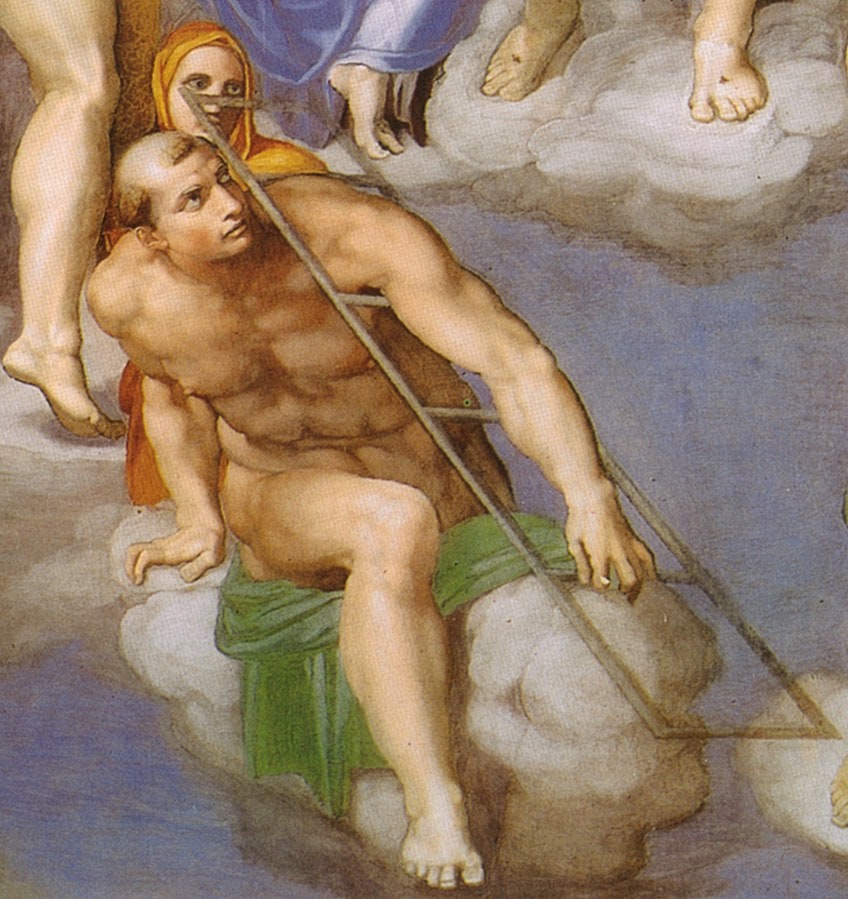
The Last Judgment
The Last Judgment painting was reproduced in 1549 by the Italian Mannerist artist, Marcello Venusti. Alessandro Farnese, an Italian cardinal, and art patron commissioned the painting’s reproduction, which is now housed in the National Museum of Capodimonte, Naples. The painting was reproduced from Michelangelo’s original work before the nude figures were covered up, giving us a unique indication of what it looked like in its “ungarbed” state.
The Last Judgment by Michelangelo has been contested, critiqued, praised, and copied numerous times and still holds true to its inherent value, which is instilling awe and fear into its viewers, whether those are 16th-century or 21st-century viewers.
The Last Judgement by Michelangelo is a visual reminder to us, not when we walk out of the Sistine Chapel, but when we walk into it. It welcomes us with its dynamism of figures all engrossed in their own evolution and journey to either Heaven or Hell. It is a visual metaphor for justice, judgment, and Michelangelo’s own love of literature and artistic mastery.
Take a look at our The Last Judgement painting webstory here!
Frequently Asked Questions
What Was The Last Judgment Painting?
The Last Judgment (1536 to 1541) painting is a fresco by Michelangelo, who was a Renaissance painter. It covers the whole altar wall of the Sistine Chapel in Italy. It depicts over 300 figures surrounding the central figure of Christ. The fresco is a depiction of Christ’s Second Coming and the Last Judgment of humanity. It was completed over 20 years after Michelangelo painted the Biblical narratives from the Book of Genesis on the Sistine Chapel’s ceiling, which includes the famous fresco called The Creation of Adam (c. 1508 to 1512).
Why Did Michelangelo Paint The Last Judgment?
Pope Clement VII (1523 to 1534) commissioned Michelangelo to paint The Last Judgment. The commission was taken over by Pope Paul III (1534 to 1549) after the death of the previously stated Pope. There are various reasons for why The Last Judgement was painted, namely because the Pope wanted to restrengthen the Papacy’s reputation and the Catholic Church’s doctrines after the Protestant Reformation as well as from the devastation from the Sack of Rome in 1527. The message the Pope conveyed through The Last Judgment painting was almost like taking a stand for all the events against the Papacy and indicating justice and judgment of the perpetrators.
How Long Did It Take to Paint The Last Judgment?
It took Michelangelo over four years to paint The Last Judgment. He started preparing the altar wall in 1535 and completed it in 1541. Michelangelo was over 60 years old when he completed the painting, and it was done over 20 years after he painted the ceiling of the Sistine Chapel and the famous fresco The Creation of Adam (c. 1508 to 1512).
Alicia du Plessis is a multidisciplinary writer. She completed her Bachelor of Arts degree, majoring in Art History and Classical Civilization, as well as two Honors, namely, in Art History and Education and Development, at the University of KwaZulu-Natal, South Africa. For her main Honors project in Art History, she explored perceptions of the San Bushmen’s identity and the concept of the “Other”. She has also looked at the use of photography in art and how it has been used to portray people’s lives.
Alicia’s other areas of interest in Art History include the process of writing about Art History and how to analyze paintings. Some of her favorite art movements include Impressionism and German Expressionism. She is yet to complete her Masters in Art History (she would like to do this abroad in Europe) having given it some time to first develop more professional experience with the interest to one day lecture it too.
Alicia has been working for artincontext.com since 2021 as an author and art history expert. She has specialized in painting analysis and is covering most of our painting analysis.
Learn more about Alicia du Plessis and the Art in Context Team.
Cite this Article
Alicia, du Plessis, ““The Last Judgement” Michelangelo – The Sistine Chapel Masterpiece.” Art in Context. October 12, 2021. URL: https://artincontext.org/the-last-judgement-michelangelo/
du Plessis, A. (2021, 12 October). “The Last Judgement” Michelangelo – The Sistine Chapel Masterpiece. Art in Context. https://artincontext.org/the-last-judgement-michelangelo/
du Plessis, Alicia. ““The Last Judgement” Michelangelo – The Sistine Chapel Masterpiece.” Art in Context, October 12, 2021. https://artincontext.org/the-last-judgement-michelangelo/.




